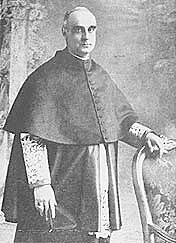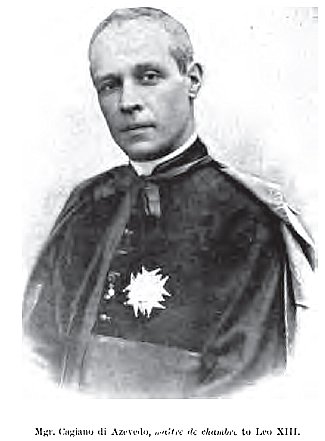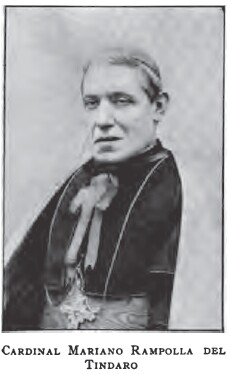SEDE VACANTE 1903
(July 20, 1903—August 4, 1903)
No coins were issued.
Personalities

LUIGI CARDINAL OREGLIA DI SANTO STEFANO (1828-1913) was a papal diplomat. He served as Nuncio to Belgium (1866-1868) and to Portugal (1868-1873). On December 22, 1873 he was named Cardinal priest of S. Anastasia, and on the next day was named prefect of the Congregation on Indulgences and Relics. In 1885 he was named Camerlengo of the Holy Roman Church, an office which he held until his death on December 7, 1913. On March 24, 1884 he became Cardinal Bishop of Palestrina; in 1889 he was advanced to be Bishop of Porto and Santa Rufina, then in 1896 to Bishop of Ostia with Velletri. He was Dean of the Sacred College of Cardinals at the time of the Conclave in 1903, and the only one who had not been created by Leo XIII (Pierconti, 464).
Prince Mario Chigi (1832-1914), son of Prince Sigismondo Chigi della Rovere Albani, principe de Farnese (1798-1877) and Amalia Charlotte, princesa Barberini Colonna, was the Hereditary Marshal of the Holy Roman Church. On his documents appointing various officials for the Conclave of 1903, he lists his full titles: Maresciallo Perpetuo della Santa Chiesa, Custode del Conclave, Nobile romano coscritto, Principe del Sacro Romano Impero, Principe di Farnese, di Soriano e di Campagnano, Duca di Ariccia e di Formello, Marchese di Magliano Pecorareccio, Signore di Castelfusano, di Cesano, dell'Olgiata e di Scrofano, Nobile di Viterbo, Patrizio di Genova e Veneto [Pierconti, 430]. He was assisted at the Conclave by his sons, Don Ludovico Chigi, Principe di Campagnano, and Don Francesco Chigi.
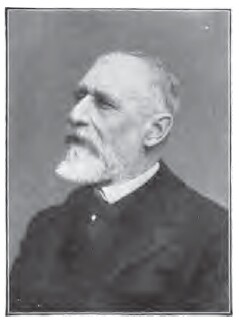
 |
Arms of Prince Mario Chigi, surmounted by princely coronet and drapery, flanked by two keys as supporters. The Ombrellone and crossed keys of the Sede Vacante above the shield. |
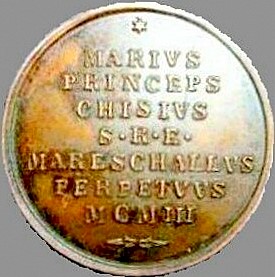 |
Mazio-Jencius 919. |
The Governor of the Conclave was Msgr. Ottavio Cagiano de Azevedo (1845-1927). He was appointed Master of the Papal Chamber (Maestro di Camera) on December 31, 1901, and Papal Majordomo (Prefect of the Papal Household) in 1901. He was also a Canon of S. Maria Maggiore (1874) and of the St. Peter's Basilica (1886). On December 11, 1905 he was named a Cardinal Deacon. He became pro-Prefect and then Prefect of the Sacred Congregation for the Religious in 1913, and Chancellor of the Holy Roman Church in December of 1915.
The Secretary of the Conclave was Monsignor Rafael Merry del Val y Zulueta (1865-1930), titular Archbishop of Nicaea (1900) [immediately above, left]. When the Secretary of the Sacred College, who would have served as Secretary of the Conclave, suddenly died, Merry del Val was elected to replace him. Merry del Val was born in London, on October 10, 1865, the son of a Spanish diplomat, the Marques Rafael Merry del Val, and Sophia de Zulueta, the daughter of the Count of Torre Diaz. The young Rafael, who grew up in England, studied at Baylis House, Slough, and then at the Jesuit College of S. Michael in Bruxelles. He then studied at Ushaw (S. Cuthbert College, the seminary for northern England). He was sent to the Scottish College in Rome for graduate study. After obtaining several doctorates (philosophy, theology, canon law) from church institutions, the Gregorian University and the Academy for Noble Ecclesiastics (he lived there in 1885), he was sent to England as secretary of Cardinal Ruffo Scilla, for the Golden Jubilee of Queen Victoria (1887). In London he received minor orders; back in Rome he received the sib-diaconate and diaconate. He served as private secretary to Archbishop Galimberti when he was on diplomatic missions in Germany and Austria-Hungary in 1887. He was ordained (December 29, 1888). He was secretary at the Nunciature in Vienna (1889-1891). Merry del Val obtained a position at the Vatican in 1891 as a Privy Chamberlain to Leo XIII. In 1896 he was secretary of the mission which decided the question of Anglican Orders. In 1897 he was sent to Canada as Apostolic Delegate to deal with pressing problems in church-state relations in the field of education. His success brought him the post of President of the Academy for Noble Ecclesiastics (1897-1903). In 1900 he was made itiular bishop of Nicaea. On June 3, 1902, he attended the Coronation of King Edward VII as the official representative of Leo XIII. During the Conclave of 1903, he played an active role in marshalling opposition to Cardinal Rampolla and support for Cardinal Sarto of Venice—which was far beyond the requirments or expectations of his office. He was made a cardinal (with the titulus of S. Prassede) by Pius X, the first, in fact, of Pius' reign (November 9, 1903), and became Secretary of State (November 12, 1903 in succession to Cardinal Rampolla. When he was deprived of the office of Secretary of State by the new Pope, Benedict XV, in August, 1914, he was appointed head of the Holy Office (1914-1930). His personal diary survives, but it has not been published.
The Maestro di Ceremonie (Prefetto delle Ceremonie pontificali) was Msgr. Francesco Riggi (Pierconti, 469). He was assisted by Msgr. Nazareno Marzolini [Grissell, pp. 28, 32, 44]
Death of Leo XIII
In 1903 Pope Leo was 93 years of age (born March 2, 1810). The Pope first began to exhibit symptoms of illness after his postprandial walk on Friday, July 3, 1903. He had suffered from insomnia on the previous two nights, and was exhibiting symptoms of general weakness. When examined by the Papal Arch-Physician, Dr. Giuseppe Lapponi, the Pope was diagnosed as having pain in his right thorax and fluid in the lungs. He was advised to rest. Cardinal Rampolla, the Secretary of State, was kept informed, as was Count Riccardo Pecci and Count Camillo Pecci, the pope's nephews. Nonetheless, the Pope continued to give audiences. A notice in L' Osservatore Romano announced that the Pope was suffering from fatigue and had been advised to take several days of absolute rest.
On Saturday night the Pope's discomfort worsened, he got no sleep, and Dr. Lapponi decided to consult with Prof. Gaetano Mazzoni, who had once operated successfully on the Pope for a cist. On Sunday, July 5, the doctors issued a bulletin that the Pope was suffering from "epatizzazione polmonare senile" in the lower lobe of the right lung. Cardinal Rampolla notified Cardinal Oreglia, the Camerlengo, of the Pope's condition, as well as the other cardinals resident in Rome. The Vicar-General of Rome, Cardinal Respighi, had a general announcement posted, calling for prayers for the Pope and ordering the exposition of the Blessed Sacrament. The Pope himself received Communion and made a formal Profession of Faith. During the following night the pope had difficulty resting, and doctors prescribed digitalis and camphor. In the evening bulletin on Monday, the doctors reported "accentuated evidence of general decline, more frequent and more superficial respiration, weak pulse, and subnormal temperature" At 10:00 p.m. the Papal Sacristan, Msgr. Guglielmo Pifferi, administered Extreme Unction. Leo asked Dr. Lapponi to be sure to tell him as the last moment approached (Pierconti, 18).
On Tuesday morning, the doctor noticed that fluid was accumulating in the lung cavity of the Pope, and that his heart function was diminished. That afternoon, Dr. Mazzoni drained the fluid from the chest cavity with a syringe, using cocaine as an anasthetic (Pierconti, 26). Later that day, a diminution in renal function was observed. But the Pope was able to sleep during the night, and his labored breathing eased. The strain on his heart was lessened. The condition remained stable until mid-Thursday afternoon, when there was a sudden change for the worse in the Pope's condition. Another medical consultant was brought in, Prof. Eugenio Rossoni. He advised another draining of the lung cavity (Pierconti, 56). This was carried out on Friday morning, July 10, by Dr. Mazzoni, who drained a liter of fluid (Pierconti, 66). This stabilized the Pope's condition for several days. On Thursday, the 16th, however, some accumulation began to be noticed again (Pierconti, 157). During the night of the 17th/18th, the Pope was distressed and unable to sleep.
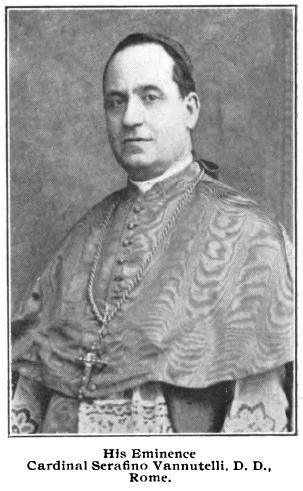 On the morning of the 19th of July, the Pope's condition was much worsened. His breathing became more rapid, his pulse weaker. Cardinal Rampolla sent for Cardinal Serafino Vannutelli, the Major Penitentiary, whose office it was to assist the Pope in his last hours (Periconti, 190). Shortly after noon he also sent a telegram to all Papal Nuncios alerting them of the Pope's grave condition and calling for prayers. The evening examination by the three attending physicians indicated that the Pope's condition had further weakened. During the night the Pope was given injections of caffeine and camphor. During the morning of the 20th of July, 1903, Cardinal Oreglia, the Cardinal Camerlengo and Dean of the Sacred College of Cardinals, took up residence in the Vatican Palace (Pierconti, 202). Late in the morning the Pope showed signs of being on the verge of the death agony. The Major Penitentiary was again summoned. Shortly thereafter his breathing became seriously labored. He expressed the wish to see the Cardinals. When they had gathered around his bed, he bade them farewell. He took Cardinal Oreglia's hand, and said, "Addio! Vi raccommando la Chiesa." Shortly after the Cardinals retired, the Pope had breathing trouble and a coughing fit. One after the other his closest familiars in the Papal Court approached the Pope, kissed his hand, and asked for his blessing. Several times he said, "Sia questo l' ultimo vale!" (This is the last farewell!). The Cardinals, Diplomats and members of the Papal Court gathered in the antechambers of the Papal Apartments. The Pope's relatives bade him farewell. In late afternoon the Pope had another crisis and lost consciousness (Pierconti, 208). The final agony lasted around half an hour. At 16,00 hours (4 p.m.), he was pronounced dead. His remains were washed and dressed in papal vestments by the Penitentiaries of the Vatican Basilica, who kept a prayerful vigil during the night.
On the morning of the 19th of July, the Pope's condition was much worsened. His breathing became more rapid, his pulse weaker. Cardinal Rampolla sent for Cardinal Serafino Vannutelli, the Major Penitentiary, whose office it was to assist the Pope in his last hours (Periconti, 190). Shortly after noon he also sent a telegram to all Papal Nuncios alerting them of the Pope's grave condition and calling for prayers. The evening examination by the three attending physicians indicated that the Pope's condition had further weakened. During the night the Pope was given injections of caffeine and camphor. During the morning of the 20th of July, 1903, Cardinal Oreglia, the Cardinal Camerlengo and Dean of the Sacred College of Cardinals, took up residence in the Vatican Palace (Pierconti, 202). Late in the morning the Pope showed signs of being on the verge of the death agony. The Major Penitentiary was again summoned. Shortly thereafter his breathing became seriously labored. He expressed the wish to see the Cardinals. When they had gathered around his bed, he bade them farewell. He took Cardinal Oreglia's hand, and said, "Addio! Vi raccommando la Chiesa." Shortly after the Cardinals retired, the Pope had breathing trouble and a coughing fit. One after the other his closest familiars in the Papal Court approached the Pope, kissed his hand, and asked for his blessing. Several times he said, "Sia questo l' ultimo vale!" (This is the last farewell!). The Cardinals, Diplomats and members of the Papal Court gathered in the antechambers of the Papal Apartments. The Pope's relatives bade him farewell. In late afternoon the Pope had another crisis and lost consciousness (Pierconti, 208). The final agony lasted around half an hour. At 16,00 hours (4 p.m.), he was pronounced dead. His remains were washed and dressed in papal vestments by the Penitentiaries of the Vatican Basilica, who kept a prayerful vigil during the night.
Next morning, July 21, at 8:45 a.m., a procession accompanied the Cardinal Camerlengo from his apartments to the deathbed of the Pope. The ceremony of the recognition was performed, the De Profundis was sung, and the Absolution of the body performed by the Camerlengo. There was no knocking on the head of the corpse of the Pope with a silver hammer; that feature of the ceremonies had long been abandoned. After the prayers were completed, the Cardinal Camerlengo sat on a stool, while the Dean of the Pronotaries Apostolic drew up the Rogito, which was then read aloud to those present. After a final blessing, the personages retired to the Hall of the Throne, where the Rogito was signed and attested. Its contents were as follows (Pierconti, 235-239):
Die XXI mensis Julii anno MCMIII
Cum Sanctissimus Dominus noster Leo divina Providentia Papa XIII sicut Altissimo placuit circa horam IV post meridiem heri in Palatio Apostolico Vaticano debitum naturae persolverit, E.mus ac R.mus Dominus S.R.E Cardinalis Camerarius, associatus ab Ill.mis et R.mis DD. Camerae Apostolicae Clericis et Cameralibus, meque Collegii Protonotariorum Apostolicorum Decano, se contulit ad Appartamentum Pontificium dicti Palatii, et ingressus una cum omnibus supradictis in cubiculo dicti Pontificis, ibi corpus ipsiusmet Pontificis adhuc in suo lecto existens exanimatum invenit. Eique debitis reverentiis et pro Eius anima precibus effusis, Annulum deinde Piscatorium sibi tradendum petiit ab Ill.mo et R.mo Domino Caietano Bisleti Praefecto dicti cubiculi, qui illico et continenter Annulum praedictum, per eum ex quadam bursa sumptum, praeladato E.mo et R.mo D. Cardinali Camerario tradidit et consignavit, quem idem E.mus et R.mus Dominus accepit ad effectum deferendi in prima proxima congregatione E.morum et R.morum DD. S.R.E. Cardinalium, deque illo dictum Ill.mum et R.mum D. Praefectum cubiculi praesentem quietavit in forma et omni, etc.
Successive praeladatus E.mus ac R.mus Dominus Cardinalis mandavit confici inventarium cubiculi praedicti et mansionum dicti Palatii cum interventu illius et illorum R.morum Clericorum Rev. Camerae Apostolicae qui ad it deputatu fuerint.
After the examination of his internal organs during the enbalming, Dr. Lapponi issued a death certificate, in which the cause of death was stated to be "polmonite adinamica con susseguente pleurite emoragiaca" (Pierconti, 217).
The Cardinals
A list of the Cardinals, their conclavisti, and other participants in the Conclave of 1903 is given in Pierconti (pp. 493-502). A complete list of Cardinals is provided by "Spectator alter" (pp. 184-186) and by Civiltà Cattolica (pp. 477-479). Thirty-eight of the Cardinals were Italian (just under 60%). The average age of the cardinals was 65.6 years.
- Luigi Oreglia di Santo Stefano (aged 75), Suburbicarian Bishop of Ostia e Velletri (since November 30, 1896), Dean of the Sacred College of Cardinals. He was born at Bene-Viagenna in the diocese of Mondovi on July 9, 1828. His career began with the appointment as Referendary of the Signature of Justice and Grace on April 15, 1858. He was sent to Holland as Internuncio. On May 4, 1866 he was named titular Archbishop of Damietta in Egypt and Nuncio in Bruxelles (1866-1868). He was subsequently transferred to Portugal (1868-1873). He was created cardinal by Pius IX on September 22, 1873, with the title of S. Anastasia. He opted for the Bishopric of Palestrina on March 24, 1884; for Porto and Santa Rufina on May 24, 1889. He was Abbot Commendatory of S. Vincenzo ed Anastasio at Tre Fontane, Cardinal Camerlengo (1885-1907), Chancellor of the Roman University, and Prefect of the Congregation Ceremonial.
- Serafino Vannutelli (aged 68), Suburbicarian Bishop of Porto e Santa Rufina Major Penitentiary Sub-Dean of the Sacred College of Cardinals. He was born at Genazzano in the diocese of Palestrina on November 25, 1834. He began his career as a minor diplomat, with the title of Auditor (Secretary) in Mexico, and then in Munich. He was promoted to the post of Apostolic Delegate to Equador and Peru with the title of Archbishop of Nicea in Turkey. On June 26, 1869 he was named Apostolic Nuncio in Bruxelles, and then in 1880 he was promoted to the post in Vienna. He was created cardinal by Leo XIII on March 14, 1887, with the title of Santa Sabina. On March 14, 1887 he opted for S. Geronimo degli Schiavi. On January 16, 1893, he was appointed Archbishop of Bologna, but on June 12 of the same year he opted for the Bishopric of Frascati. He was Major Penitentiary and Secretary of the Inquisition.
- Mario Mocenni (aged 80), Suburbicarian Bishop of Sabina. He was born in Montefiascone on January 22, 1823. His career began with a secretaryship in the Nunciature in Vienna. On July 20, 1876, he was named titulary Archbishop of Heliopolis and sent on a special mission to the states of South America, and then made Internuncio to Brazil. In 1882 he became Undersecretary (Sostituto) in the Secretariat of State in Rome. On January 16, 1893, he was named a cardinal by Leo XIII, with the title of S. Bartolommeo. On May 18, 1894, he opted for the Bishopric of Sabina. He was Abbot Commendatory of Farfa.
- Antonio Agliardi (aged 70), Suburbicarian Bishop of Albano. Vice-Chancellor of the S.R.E. [Pierconti, 178]. He was born on September 4, 1832, at Cologno al Serio in the diocese of Bergamo. His first appointment was as Minutante in the SC de propaganda fide. He was named titular Archbishop of Caesarea on September 23, 1884, and sent to India. Secretary of Extraordinary Ecclesiastical Affairs in 1887. Nuncio in Munich. Nuncio in Vienna. He was created cardinal by Leo XIII June 22, 1896 with the title of SS. Nereus and Achilles. He opted for the Bishopric of Albano at the Consistory of December 14, 1899. He was Prefect of the Economy of the SC de Propaganda fide.
- Vincenzo Vannutelli (aged 66), Suburbicarian Bishop of Palestrina. He was born at Genazzano in the diocese of Palestrina on December 5, 1836. He was named Auditor in the Nunciature in Bruxelles in 1866. In 1875 he became Sostituto in the Secretariat of State. On January 20, 1880, he was appointed titular Archbishop of Sardis in Turkey and sent as Apostolic Delegate to the Sultan of Constantinople. In 1882 he was sent as Internuncio to Brazil. On his return he was sent as papal representative to Russia to the Coronation of Emperor Alexander III. He was then Nuncio in Portugal. On December 30, 1889, he was named cardinal in petto, which was finally made public on June 23, 1890. He received the titulus of S. Silvestro in capite, and on April 19, 1900, he opted for the Bishopric of Palestrina. He was Protector of Portugal.
- Francesco Satolli (aged 64), Suburbicarian Bishop of Frascati. He was born at Marsciano in the diocese of Perugia on July 21, 1839. Professor at the Propaganda. Rector of the Greek-Ruthenian College in Rome. In 1886 he was named Rector of the Academy for Noble Ecclesiastics. On June 1, 1888, he was appointed titular Bishop of Lepanto and Apostolic Delegate to the United States of America. Pope Leo XIII named him a cardinal on November 29, 1895. Archpriest of the Lateran Basilica. Prefect of the SC of Studies.
- Jose Sebastião Neto, OFM (aged 62), Cardinal Priest of SS. XII Apostoli. Patriarch of Lisbon
- Alfonso Capecelatro, Orat.(aged 79), Cardinal Priest of S. Maria del Popolo (from January 15, 1886), previously Cardinal Priest of SS. Nereus and Achilles (July 27, 1885). Born at Marseille on February 5, 1824. Archbishop of Capua (August 20, 1880). Bibliothecarius S.R.E.
- Benoit-Marie Langenieux (aged 78), Cardinal Priest of S. Giovanni a Porta Latina. Archbishop of Reims. He was born at Villeneuve in the diocese of Lyon on October 15, 1824. He was appointed Bishop of Tarbes on June 25, 1873, and promoted to be Archbishop of Reims on December 24, 1874. He was created cardinal by Leo XIII on June 7, 1886.
- James Gibbons (aged 80), Cardinal Priest of S. Maria in Trastevere. Archbishop of Baltimore
- Mariano Rampolla del Tindaro (aged 59), Cardinal Priest of S. Cecilia. ex-Secretary of State of His Holiness. Archpriest of the Vatican Basilica.
- François-Marie-Benjamin Richard (aged 84), Cardinal Priest of S. Maria in Via. Archbishop of Paris. He was born at Nantes on March 9, 1819. On December 22, 1871, he was appointed Bishop of Belley; on July 5, 1875, he was named Coadjutor of the Archbishop of Paris, with the title of Archbishop of Larissa. He succeeded to the Archbishopric on July 6, 1886. Leo XIII named him a cardinal on May 24, 1889. He was a member of the Congregations of Bishops and Regulars, the Index, Rites, and Indulgences and Relics.
- Pierre-Lambert Goosens (aged 76), Cardinal Priest of S. Croce in Gerusalemme. Archbishop of Malines. Born at Perck in the diocese of Malines on June 18, 1827. On June 1, 1883, he was named Coadjutor of the Bishop of Namur, and titular Bishop of Abdera in Thrace. He succeeded on July 6, 1883. On March 24, 1884, he was promoted to be Archbishop of Malines-Bruxelles. On May 26, 1889, he was named to the College of Cardinals. He was member of the SC on the Council, Index, Discipline of Regulars, and Ceremonial.
- Anton Joseph Gruscha (aged 82), Cardinal Priest of S. Maria degli Angeli. Archbishop of Vienna
- Angelo Di Pietro (aged 75), Cardinal Priest of S. Lorenzo in Lucina. Pro-Datary of His Holiness.
- Michael Logue (aged 62), Cardinal Priest of S. Maria della Pace. Archbishop of Armagh
- Kolos Ferenc Vaszary, OSB (aged 71), Cardinal Priest of Ss. Silvestro e Martino ai Monti. Archbishop of Esztergom
- Georg von Kopp (aged 65), Cardinal Priest of S. Agnese fuori le mura. Bishop of Wroclaw (Breslau)
- Adolph-Louis-Albert Perraud, Orat. (aged 74), Cardinal Priest of S. Pietro in Vincoli. Bishop of Autun. He was born at Lyon on February 7, 1828. On May 4, 1874, he was appointed Bishop of Autun. Leo XIII created him a cardinal in petto on January 16, 1893, and publicized the appointment in November of 1895. He was a member of the Congregation of Bishops and Regulars, the Propaganda, the Index, Indulgences and Relics, and Studies.
- Victor-Lucien-Sulpice Lecot (aged 72), Cardinal Priest of S. Pudenziana. Archbishop of Bordeaux. Born at Montescours-Lizerolles in the Diocese of Beauvais on January 8, 1831. Studied at the seminaries of Compiègne and Beauvais. Science teacher at the minor seminary. Named Bishop of Dijon on March 2, 1886, preconised on June 22, and consecrated on July 11 at Compiègne. Named Archbishop of Bordeaux on June 3, 1890. Created cardinal by Leo XIII on June 12, 1893. Papal Legate at the 50th anniversary celebration of the visions of Lourdes on February 11, 1908.
- Giuseppe Melchiorre Sarto (aged 68), of Riese, near Castelfranco in the Veneto. His grandfather and his father were borough-messenger of the village. His uncle was valet de chambre of the Patriarch of Venice, Cardinal Jacopo Monico (1826-1851), who was also from Riese. Giuseppe studied at the seminary of Padua. He was ordained on September 18, 1858, by Msgr. Antonio Farina, Bishop of Treviso. He was named chaplain in the village of Tombolo (1858-1867), which made him a subject of Austria until 1859. In 1867 he was appointed parish priest of S. Bartolommeo in the village of Salzano, near Mirano in the Veneto, where he remained for nine years; he had two curates. In 1875, the Bishop of Treviso, Frederico Zinelli, appointed Sarto canon of the cathedral and spiritual director of the diocesan seminary, where he took up residence; this was confirmed by Rome on July 21, 1875. He was promoted to the post of Diocesan Chancellor, which he held along with the other two positions. When the Bishop suffered a stroke, Sarto had to assume many of his duties. When the Bishop died in 1879, Sarto became Vicar-general, and the Cathedral Chapter assigned him the administrative duties of the diocese during the Sede Vacante. He fulfilled the same functions when the new bishop, a school classmate from the seminary in Padua, Msgr. (later Cardinal) Giuseppe Callegari, was transferred to the Bishopric of Padua in 1882. He accompanied Bishop Callegari to Rome for his consecration. With the patronage of this bishop and of Cardinal Parocchi, the head of the Vatican office which recommended bishops for Italian sees, Sarto was appointed Bishop of Mantua on November 10, 1884. Cardinal Parocchi was himself a Mantuan, and both he and the Vatican were dismayed at the collapse of Mantuan catholicism. He was consecrated in Rome on November 23, 1884, in the Church of S. Apollinaire by Cardinal Parocchi, assisted by Bishop Pietro Rota (Thebes in Egypt) and Bishop Giovanni-Maria Berengo (Udine). Both co-consecrators had been failed Bishops of Mantua. The diocesan seminary was the centerpiece of his reform movement, and he several times assumed teaching and examining duties there himself. For several years he was the Professor of Dogmatic Theology and in 1891-1892 he substituted as Professor of Moral Theology. He was insistant on the teaching of Thomas Aquinas and the use of Gregorian chant. In September 1888, he held the first diocesan synod in Mantua in 240 years. When the Patriarch of Venice, Cardinal Agostini, died during a regional episcopal conference in 1891, the talk was lively in favor of Bishop Sarto as his successor, in particular on the part of Cardinal Ferrari of Milan, and indeed Sarto was appointed. He remained in Mantua for two years, though, because the Italian Government refused to grant the Exequatur, which would allow him to assume his temporalities in Venice. The Government's claim was that it was the successor of the Venetian Doge and Signoria, and had therefore acquired the right to nominate the Patriarch. The cardinal's hat came as a matter of course in 1893. Cardinal Priest of S. Bernardo alle Terme (1893-1903). Patriarch of Venice (June 15, 1893-1903). He had never travelled outside Italy. He had not even been to Rome until 1877.
- Ciriaco María Sancha y Hervás (aged 70), Cardinal Priest of S. Pietro in Montorio. Archbishop of Toledo
- Domenico Svampa (aged 52), Cardinal Priest of S. Onofrio. Archbishop of Bologna. His ballot has been preserved, and is published on the website http://www.papalartifacts.com/. On the back of a Conclave talley sheet, he noted that he had voted for Cardinal Sarto on each of the seven ballots.
- Andrea Carlo Ferrari (aged 52), Cardinal Priest of S. Anastasia. Archbishop of Milan
- Girolamo Maria Gotti, OCD (aged 69) (born Giovanni Antonio Benedetto), Cardinal Priest of S. Maria della Scala (1895-1916). Joined the Discalced Carmelite Order in 1858. Teacher of Mathematics at a naval college. Assistant to the Master-General of the Discalced Carmelites in Rome. Procurator-General of the Discalced Carmelites. Master-General of the Discalced Carmelites (1881). Apostolic Delegate to Brazil (1892-1895), after the creation of a Republic, for which post he was named titular Archbishop of Petra (now in the Hashemite Kingdom of Jordan) (1892-1895). Prefect of the SC of Indulgences and Rites (1896-1898). Prefect of the SC of Bishops and Regulars (1899-1902). Prefect of the SC de propaganda fide (1902-1903; 1903-1916). As such he was a strong opponent of black segregation in the US. Protector of the Irish, Scottish, Armenian, Greek, and North American Colleges in Rome. It was rumored that one of his lobbyists was Ernesto Pacelli, his colleague as financial advisor to Leo XIII [John F. Pollard, Money and the Rise of the Modern Papacy (2005) p. 97; Rupert Klieber, "Efforts and Difficulties in Financing the Holy See by Means of Peter's Pence....," in Vincent Viaene (ed.), The Papacy and the New World Order (Leuven 2005), pp. 288-289]. R. De Cesare wrote of Gotti in 1901, "Of all the Cardinals who were Nuncios, there are several who have given evidence of greater capacity than either Vannutelli or Gotti. But it is necessary to recollect that the Sacred College is an elective body, and, as is the case in all such assemblies, good fortune and merit do not always go together. Mgr. Gotti is of a cold and impenetrable nature, full of scruples and prejudice; he is a violent anti-American; and, if he were Pope, he would very likely abandon the prudent line of conduct followed by Leo XIII with regard to American affairs, and would create a great disturbance, perhaps even having recourse to extreme measures...."
- Salvador Casañas y Pagés (aged 68), Cardinal Priest of Ss. Quirico e Giulitta. Bishop of Barcelona
- Achille Manara (aged 75), Cardinal Priest of S. Pancrazio. Archbishop of Ancona, bishop of Umana
- Domenico Ferrata (aged 56), Cardinal Priest of S. Prisca ex-Prefect, SC of Bishops
- Serafino Cretoni (aged 69), Cardinal Priest of S. Maria sopra Minerva ex-Prefect, SC on Rites.
- Giuseppe Prisco (aged 69), Cardinal Priest of S. Sisto. Archbishop of Naples. Born at Boscotrecase in the diocese of Naples on September 8, 1836. On November 30, 1896, he was created Cardinal Deacon of S. Cesareo in Palatio. When he was appointed Archbishop of Naples on March 24, 1898, he was transferred to the Order of Cardinal Priests and assigned the title of S. Sisto. He was appointed to the SC of the Index, of Rites, and of the Holy House of Loreto.
- José Martín de Herrera y de la Iglesia (aged 67), Cardinal Priest of S. Maria in Traspontina. Archbishop of Santiago de Compostela
- Pierre-Hector Coullie (aged 74), Cardinal Priest of SS. Trinità al Monte Pincio. Archbishop of Lyon. Born in Paris on March 14, 1829, he studied at Saint-Sulpice. Ordained priest on December 23, 1854. Coadjutor of Bishop Dupanloup at Orleans in 1876. Given the title of Bishop of Sidon, he was consecrated in Notre Dame de Paris on September 19, 1877. On October 11, 1878, he became Bishop of Orleans. On June 13, 1893, he was promoted to be Archbishop of Lyon, preconised on June 15, enthroned on September 14. Leo XIII named him cardinal in the Consistory of April 19, 1897.
- Guillaume-Marie-Joseph Labouré (aged 61), Cardinal Priest of S. Maria Nuova. Archbishop of Rennes. Born at Achiet-le-Petit in the diocese of Arras on October 27, 1841. He was named Bishop of Le Mans on March 27, 1885; and promoted to be Archbishop of Rennes on June 15, 1893. He was created Cardinal by Leo XIII on April 19, 1897. He was a member of the Consistorial Congregation, the Council, the Propaganda, and Rites.
- Giovanni Battista Casali del Drago (aged 65), Cardinal Priest of S. Maria della Vittoria
- Francesco di Paola Cassetta (aged 61), Cardinal Priest of S. Crisogono and SS. Vito, Modesto e Crescenzia in commendam
- Alessandro Sanminiatelli-Zabarella (aged 62), Cardinal Priest of Ss. Marcellino e Pietro
- Gennaro Portanova (aged 57), Cardinal Priest of S. Clemente. Archbishop of Reggio Calabria
- Giuseppe Francica Nava di Bontife (aged 57), Cardinal Priest of Ss. Giovanni e Paolo. Archbishop of Catania
- François-Desiré Matthieu (aged 64), Cardinal Priest of S. Sabina former Archbishop of Toulouse. He was born at Eurville in the diocese of Nancy on May 27, 1839. Ordained in 1863 he became a teacher of history and literature at the minor seminary of Pont-à-Mousson. In 1878 he received the Doctorat ès-lettres, with a thesis entitled "L'Ancien régime dans la province de Lorraine", which was awarded the Prix Gobert. On January 3, 1893, he became Bishop of Angers, preconised on January 19, and consecrated on March 20. On May 30, 1896, he was transferred and became Archbishop of Toulouse. On June 19, 1899, Pope Leo XIII named him cardinal, and brought him to Rome. He was a member of the Congregation of Bishops and Regulars, the Council, the Propaganda, the Oriental Church, Rites, and Studies. In 1906, he was elected a member of the Académie Française.
- Pietro Respighi (aged 59), Cardinal Priest of Ss. Quattro Coronati. Vicar-General of Rome.
- Agostino Richelmy (aged 52), Cardinal Priest of S. Eusebio. Archbishop of Turin
- Sebastiano Martinelli, OESA (aged 54), Cardinal Priest of S. Agostino
- Casimiro Gennari (aged 63), Cardinal Priest of S. Marcello
- Lev Skrbensky z Hriste (aged 40), Cardinal Priest of S. Stefano al Monte Celio. Archbishop of Prague
- Giulio Boschi (aged 65), Cardinal Priest of S. Lorenzo in Panisperna. Archbishop of Ferrara
- Jan Kniaz Puzyna de Kozielsko (aged 60), Cardinal Priest of Ss. Vitale, Valeria, Gervasio e Protasio (1902-1911). Bishop of Kraków (1895-1911). He was born at Gwozdziec in the diocese of Lemberg (Lviv) on September 14, 1842. He was ordained in 1878. He was canon of the cathedral of Przemysl. On February 20, 1886, he was named titular Bishop of Memphis in Egypt (1886-1895) and Latin Auxiliary of the Bishop of Lemberg (Lviv, in the Ukraine). He was transferred to Kraków on January 22, 1895. On April 15, 1901, he was created cardinal by Leo XIII. He was a member of the Congregations Consistorial, Bishops and Regulars, the Index, and Studies.
- Bartolomeo Bacilieri (aged 61), Cardinal Priest of S. Bartolomeo all’Isola. Bishop of Verona
- Carlo Nocella (aged 76), Cardinal Priest of S. Callisto ex-Secretary, SC Consistorial.
- Beniamino Cavicchioni (aged 66), Cardinal Priest of S. Maria in Ara Coeli ex-Secretary SC of the Council.
- Andrea Aiuti (aged 54), Cardinal Priest without titulus, Nuncio to Portugal.
- Emidio Taliani (aged 65), Cardinal Priest without titulus, Nuncio to Austria
- Sebastián Herrero y Espinosa de los Monteros (aged 81), Cardinal Priest of Ss. Bonifacio ed Alessio. Archbishop of Valencia
- Johannes Katschthaler (aged 71), Cardinal Priest of S. Tommaso in Parione. Archbishop of Salzburg
- Antonius Hubert Fischer (aged 63), Cardinal Priest of Ss. Nereo ed Achilleo. Archbishop of Cologne
- Luigi Macchi (aged 71), Cardinal Deacon of S. Maria in Via Lata . ex-Secretary of Briefs. Prior Diaconum.
- Andreas Steinhuber, SJ (aged 77), Cardinal Deacon of S. Agata alla Suburra. ex-Prefect of the Congregation of the Index.
- Francesco Segna (aged 66), Cardinal Deacon of S. Maria in Portico. Prefect of the Vatican Archives.
- Raffaele Pierotti, OP (aged 66), Cardinal Deacon of Cardinal-Deacon of SS. Cosma e Damiano.
- Francesco Salesio della Volpe (58), Cardinal Deacon of S. Maria in Aquiro.
- José de Calasanz Vives y Tutó, OFM Cap. (aged 49), Cardinal Deacon of S. Adriano al Foro.
- Luigi Tripepi (aged 67), Cardinal Deacon of S. Maria in Domnica ex-Prefect SC Indulgences and Relics.
- Felice Cavagnis (aged 62), Cardinal Deacon of S. Maria ad Martyres (Pantheon). ex-Secretary SC Extraordinary Ecclesiastical Affairs.
- Pietro Celesia, OSB (aged 89), Cardinal Priest of S. Marco. Archbishop of Palermo. He was at sea on his way to the Conclave at the time of the election.
- Francis Patrick Moran (aged 72), Cardinal Priest of S. Susanna. Archbishop of Sydney
Preliminaries
The First Congretation of Cardinals after the death of Pope Leo XIII took place on the morning after his death, July 21, at 10:30. Twenty-seven Cardinals attended. The Cardinal Camerlengo, Cardinal Luigi Oreglia, presided. The cardinals were seated according to their rank in the Sacred College, and, within the ranks, according to their seniority. An oath of secrecy was administered to each of the participants. Owing to the death of Msgr. Volpini, the Secretary of the Consistorial Congregation, who would have been Secretary of the Conclave ex officio, the Cardinals elected Msgr. Raffaele Merry del Val, titular Archbishop of Nicaea, as his replacement. While this meeting was in progress, in the death-chamber, a death-mask of Pope Leo XIII was being made. At 4:30 p.m. Dr. Lapponi began the enbalming of the body of the late Pope, during which an autopsy of the body was performed (details in Pierconti, 242-243; Grissell, p. 12). That evening the remains were placed on view in the Throne Room. Late that evening the Maestro di Camera superintended the removal the praecordia of the Pope to the Church of SS. Vincenzo ed Anastasio, to be entombed (Pierconti, 246-248).
The Second Congregation of Cardinals took place on Wednesday, July 22, at 10:00 a.m. Twenty-seven cardinals attended. It was decided that the body of the late Pope would be transferred to the Vatican Basilica that evening, under the direction of Msgr. Riggi, the Maestro di Ceremonie (Pierconti, 304-310), and, by unanimous vote, that the Conclave would be held in Rome.
At the Fifth Congregation, on Saturday, July 25, with thirty-eight cardinals in attendance, the diplomatic corps was received by the College of Cardinals.
The Ceremonies of the novendiales began in St. Peter's Basilica on the morning of Thursday, July 23 (Pierconti, 333). The Third Congregation decided that the entombment of the deceased would take place on evening of the the 25th of July.
On Sunday, July 26, the Last Will and Testament of Leo XIII (dated July 8, 1900) was opened and read in the Consistorial Hall of the Vatican Palace (Pierconti, 384-386). The executors were Cardinal Rampolla, Cardinal Mocenni and Cardinal Cretoni. The pope had left everything to the Holy See. There was also an envelope with 50,000 lire in it, for distribution to the poor of Rome, 20,000 lire for the poor of Perugia, and 10,000 lire for the poor of Carpineto. [Grissell, p. 10].
On Tuesday, July 28, the solemn Requiem Mass was sung by Cardinal Serafino Vannutelli, the Major Penitentiary.
On Wednesday, July 29, the solemn Requiem Mass was sung by Cardinal Kopp of Breslau (Wroclaw).
On Thursday, July 30, after the solemn Requiem Mass in the Sistine Chapel, sung by Cardinal Vincenzo Vannutelli, the Oration pro pontifice defuncto was pronounced by Msgr. Aurelio Galli, clericus beneficiatus of the Vatican Basilica [Latin text with English translation in Schmitz II, pp. 43-52].
Opening of the Conclave
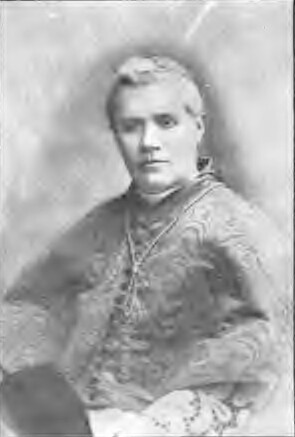
The Conclave of 1903 began on Friday, July 31. There were 64 cardinals, but two (Cardinal Moran of Sydney and Cardinal Celesia of Palermo) did not participate. For the first time, an American, James Cardinal Gibbons, Archbishop of Baltimore, participated in a papal election. Among the 'papabili' were said to be Cardinals Antonio Agliardi, Alfonso Capecelatro, Angelo di Pietro, Girolamo Gotti, Mariano Rampolla, Giuseppe Sarto (right), Serafino Vanutelli, and Domenico Svampa. The favorite candidate at the Conclave was the Secretary of State (1887-1903), Mariano Cardinal Rampolla. His principal antagonist was the Camerlengo, Cardinal Oreglia.
At 10:15, the Mass of the Holy Spirit was sung in the Capella Paolina by Cardinal Serafino Vannutelli, sub-Dean of the Sacred College of Cardinals. Fifty-nine cardinals participated (list in Pierconti, 480. At the end of the Mass, the discourse de elegendo pontifice was given by Msgr. VIncenzo Sardi (text in Pierconti, 476-480; and in Schmitz II, 69-77, with English translation). At 5:00 p.m sixty-two Cardinals assembled in the Capella Paolina and sang the Veni Creator. That evening, at 9:30, the Conclave was sealed (Pierconti, 487-492).
Proceedings
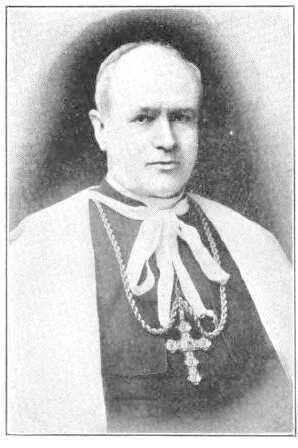 In the first scrutiny, on the morning of Saturday, August 1, Cardinal Rampolla received 24 votes, Cardinal Gotti 17, Cardinal Sarto 5, Cardinal Vannutelli 4, Cardinals Oreglia, Di Pietro and Capecelatro two each; and single votes for Agliardi, Ferrata, Cassetta, Portanova, Segna and Tripepi (Sladen, 79; Mathieu, 128; Irish Ecclesiastical Record 372). The scrutiny was not followed by an accessio vote, the cardinals having decided unanimously to abolish the practice. At the afternoon scrutiny, Rampolla increased his votes to 29 and Sarto to 10; Vannutelli fell back to one vote, and Gotti to 16 (Sladen 80, confirmed by Cardinal Svampa's talley sheet). Black smoke was seen from the chimney of the Sistine Chapel at 6:38 p.m. (Pierconti, 513).
In the first scrutiny, on the morning of Saturday, August 1, Cardinal Rampolla received 24 votes, Cardinal Gotti 17, Cardinal Sarto 5, Cardinal Vannutelli 4, Cardinals Oreglia, Di Pietro and Capecelatro two each; and single votes for Agliardi, Ferrata, Cassetta, Portanova, Segna and Tripepi (Sladen, 79; Mathieu, 128; Irish Ecclesiastical Record 372). The scrutiny was not followed by an accessio vote, the cardinals having decided unanimously to abolish the practice. At the afternoon scrutiny, Rampolla increased his votes to 29 and Sarto to 10; Vannutelli fell back to one vote, and Gotti to 16 (Sladen 80, confirmed by Cardinal Svampa's talley sheet). Black smoke was seen from the chimney of the Sistine Chapel at 6:38 p.m. (Pierconti, 513).
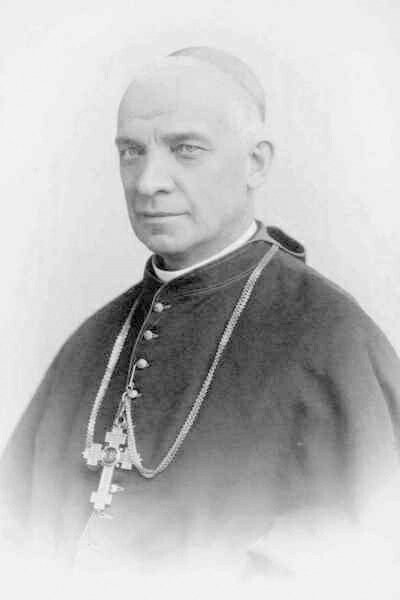 On Sunday, August 2, at the morning scrutiny, Rampolla still had his 29 votes, but Sarto had increased his support to 21; Gotti had 9 adherents [Sladen, 80] [photo of Cardinal Gotti at left], with one vote each for Oreglia, Di Pietro and Capecelatro [Pierconti, 663]. At this point there was a most unwelcome intervention: the veto of the Austrian Emperor Franz Josef, carried by Cardinal Jan Puzyna of Krakow (photo at right), was pronounced against Rampolla. It appears that the directions had come straight from the Emperor himself rather than his government; he had tried to have the Cardinal Archbishop of Vienna, Anton Gruscha, carry the exclusiva, but the Cardinal refused, both on grounds of principle and of personal friendship (Radziwill, 188-190). His statement to Cardinal Oreglia, the Dean and Camerlengo, was as follows [Annuaire pontificale catholique (1905), p. 137]:
On Sunday, August 2, at the morning scrutiny, Rampolla still had his 29 votes, but Sarto had increased his support to 21; Gotti had 9 adherents [Sladen, 80] [photo of Cardinal Gotti at left], with one vote each for Oreglia, Di Pietro and Capecelatro [Pierconti, 663]. At this point there was a most unwelcome intervention: the veto of the Austrian Emperor Franz Josef, carried by Cardinal Jan Puzyna of Krakow (photo at right), was pronounced against Rampolla. It appears that the directions had come straight from the Emperor himself rather than his government; he had tried to have the Cardinal Archbishop of Vienna, Anton Gruscha, carry the exclusiva, but the Cardinal refused, both on grounds of principle and of personal friendship (Radziwill, 188-190). His statement to Cardinal Oreglia, the Dean and Camerlengo, was as follows [Annuaire pontificale catholique (1905), p. 137]:
Honori mihi duco, ad hoc officium jussu altissimo vocatus, humillime rogare vestram Eminentiam, prout Decanum Sacri Collegii Eminentissimorum Sacrae Ecclesiae Cardinalium et Camerarium S. R. E. ut ad notitiam suam percipiat idque notificare et declarare modo officioso velit; nomine et auctoritate Suae Maiestatis Apostolicae Francisci Josephi imperatoris Austriae et regis Hungariae, jure et privilegio antiquo uti volentis, veto exclusionis contra Eminentissimum dominum meum Cardinalem Marianum Rompolla del Tindaro.
Oreglia immediately told the Cardinals; "This communication cannot be received officially or unofficially. No cardinal is to give any consideration to this 'veto' and all are to continue to vote according to their conscience." [John-Peter Pham, Heirs of the Fisherman: Behind the Scenes of Papal Death and Succession (Oxford: OUP 2004), chapter 4, citing Carlo Snider, L' episcopato del cardinale Andrea C. Ferrara, Volume II, "I tempi di Pio X", who prints Cardinal Ferrari's detailed diary of the Conclave.]
Rampolla's immediate reply was masterful, "Vehementer doleo de gravi vulnere illato Ecclesiae libertati; quod autem ad me attinet, nihil gratius, nihil iucundius accidere poterat." This was the last time a veto was attempted; the Austro-Hungarian Empire, and the claim to an Imperial Veto along with it, became defunct in November 1918. In St. Peter's Square smoke was seen coming from the chimney of the Sistine Chapel at 11:22 a.m. (Pierconti, 516). At the afternoon scrutiny of August 2, Rampolla's vote actually increased to 30, but Sarto had received 24 votes; Gotti still had 3 (Sladen, 81). Black smoke poured from the Sistine Chapel chimney at 6:34 p.m. It was estimated that 100,000 persons were waiting in the Piazza San Pietro to see it (Pierconti, 521).
On the morning of Monday, August 3, Sarto drew ahead of Rampolla, with 27 votes to 24, with Gotti again receiving 9 (Sladen, 82). The Austrian veto was having its effect. But the black smoke poured forth again at 11:18 (Pierconti, 525). The afternoon scrutiny saw a major shift in the voting: Sarto had 35, Rampolla 16, Gotti 7, Oreglia 2, Capecelatro 1, and one blank ballot (Pierconti 663). The sfumata began at 6:27 p.m., and again the smoke was black (Pierconti, 527).
Election
On Tuesday, August 4, on the seventh ballot, Giuseppe Cardinal Sarto, Patriarch of Venice, was elected, receiving 50 votes. Rampolla still had 10 and Gotti 2. The rumor began to spread at 10:25, Pierconti notes (p. 530), that a new pope had been chosen, but the names of several cardinals, including Sarto, were being noised about. Meanwhile, at 10:50, Msgr. Merry del Val (the Secretary of the Conclave) and Msgr. Francesco Riggi (who was a Protonotary Apostolic as well as Principal Ceremoniere) were summoned to the Sistine Chapel by Cardinal Felice Cavagnis, the junior Cardinal Deacon. Their presence was desired to witness the Acceptance of his election by Cardinal Sarto, and his choosing of a papal name. The heads of each of the orders, Cardinals Oreglia, Neto, and Macchi, stood before Cardinal Sarto's throne, while Cardinall Macchi asked for Cardinal Sarto's acceptance of his canonical election. When this was given, he asked Sarto by what name he wished to be called. Sarto took the name Pius X. Monsignor Riggi then drew up an official document attesting to the event (Pierconti, 531-532):
In nomine Domini. Amen.
Ego Franciscus Riggi, Protonotarius Apostolicus et S. Sedis Caeremoniarum Praefectus, ex officio rogatus, attestor et omnibus notum facio, Eminentissimum et Reverendissimum Dominum Josephum, Titulo S. Bernardi ad Thermas, S. R. E. Presbyterum Cardinalem Sarto acceptasse electionem de se factam in Summum Pontificem, sibique nomen imposuisse Pium X, ut de hoc publica quaecumque instrumenta confici possint.
Acta haec sunt in Conclavi habito in Vaticano Palatio post obitum fel. rec. Leonis XIII, hac die IV Augusti A. D. MCMIII, testibus adhibitis
ac rogatis Ill.mo ac Rev.mo Dom. Raphaele Merry del Val Archiep. Nicaeno, Sacri Collegii Secretario, et RR.DD. Nazareno Marzolini et Francisco Ciocci consociis meis, Apostolicarum Caeremoniarum Magistris.
At 11:50 a.m. the announcement of the election was made from the balcony above the central door of the Vatican Basilica by Cardinal Macchi, the Cardinal Protodeacon.
The Coronation of Pope Pius X took place on Sunday, August 9, 1903, inside the Vatican Basilica. The triregnum (tiara) was placed on his head by Cardinal Luigi Macchi (Pierconti, 636-637).
The new pope presently issued an edict, the constitution Commissum nobis (January 20, 1904), forbidding the exercise of any veto in future conclaves:
Verum, quandoquidem et experientis docuerit, hactenus constituta ad impediendum civile Veto, seu Exclusivam non its votis respondisse, et ob mutata temporum adiunctas huiusmodi civilis potestatis immixtio nostra aetate multo videatur magis omni rationis et aequitatis fundamento destituta, idcirco Nos, pro Apostolico Nobis commisso munere, et Praedecessorum Nostrorum vestigiis inhaerentes, re mature deliberata, certa scientia et proprio motu, civile Veto, sive Exclusivam, quam dicunt, etiam sub forma simplicis desiderii, itemque omnes interventus, intercessiones quaslibet omnino reprobamus edicentes licere nemini, ne supremis quidem civitatum moderatoribus, quovis praetextu se interponere aut ingerere in gravi negotio electionis Romani Pontificis.
Quamobrem in virtute sanctae obedientiae, sub interminatione divini iudicii et poena excommunicationis latae sententiae speciali modo reservatae futuro Pontifici, onmnes et singulos S. R. E. Cardinales, tam praesentes quam futuros, pariterque Secretarium S. Collegii Cardinalium aliosque onmes in Conclavi partem habentes, prohibemus, ne, quovis praetextu, a quavis civili potestate munus recipiant Veto sive Exclusivam, etiam sub forma simplicis desiderii, proponendi, ipsumve hoc Veto, qualibet ratione sibi cognitum, patefaciant sive universo Cardinalium Collegio simul congregato, sive singulis purpuratis Patribus, sive scripto, sive ore, sive directo ac proxime, sive oblique ac per alios. Quam prohibitionem extendi volumus ad memoratos omnes interventus, intercessiones aliosque modos quoslibet, quibus laicae potestates cuiuslibet gradus et ordinis voluerint sese in Pontificis electione immiscere.
His strictures were repeated and amplified by Pope Paul VI in his constitution Summi Pontificis Eligendo (October 1, 1975), in the oath required of Cardinal-electors (Caput III. 49):
itemque nullo modo a quavis civili potestate, quovis nomine, munus proponendi veto seu exclusivam, etiam sub forma simplicis optationis, esse recepturos, neque ipsum veto, qualibet ratione nobis cognitum, patefacturos; nullique interventui, intercessioni aliique cuilibet modo, quo auctoritates saeculares cuiuslibet ordinis et gradus, vel quivis hominum coetus vel personae voluerint sese Pontifìcis electioni immiscere, auxilium vel favorem praestaturos.
The officials participating in the Conclave also have to swear an oath, in which the following is included (Caput II. 46):
Pariter promitto et iuro me nulli interventui, intercessioni aliive cuilibet modo, quo civiles potestates cuiuslibet ordinis et gradus, vel quivis hominum coetus vel personae voluerint sese electioni Pontificis immiscere, auxilium vel favorem praestaturum.
Bibliography
An eyewitness description of all of the events is provided by Hartwell de la Garde Grissell, Chamberlain of Honor di numero to several popes, in his Sede Vacante, being a Diary written during the Conclave of 1903, with Additional Notes on the Accession and Coronation of Pius X (Oxford 1903). Douglas Sladen, The Secrets of the Vatican (Philadelphia 1907) 79-82. Another moment-by-moment account, with full documentation, is given by Adriano Pierconti, Da Leone XIII a Pio X. Diario del giorno 3 Luglio al 9 Agosto 1903, con documenti inediti (Roma: Cooperativa Poligrafica Editrice 1904). Cesare De Agostini, Segregati da Dio: tutti i conclavi del '900 (Casale Monferrato: Piemme 2002).
R. De Cesare, "The Next Conclave," The North American Review 173 (1901) 594-608.
On the Austrian veto, see [Cardinal François Désiré Mathieu], Les derniers jours de Léon XIII et le Conclave, par un Temoin (Paris: Librarie Victor Lecoffre 1904), 98-115, and for the voting statistics pp. 128-129. The details of the votes were published by the Analecta Ecclesiastica (Rome), from which they were reprinted by the Irish Ecclesiastical Record 14 (1903) 372-373. [Anon.], Ignis Ardens: Pio X e la Corte pontificia (Milano 1907), pp. 31-98.
Also: D. Giuliani, Un mois à Rome. La maladie, la mort, les funérailles de Léon XIII. L' élection de Pie X (Lyon-Paris: Librairie catholique Emmanuel Vitte 1903). [Spectator Alter], Die Krisis im Papsttum (Berlin 1904) 138-208; E.C. Smith, Life of Pius X (New York: American Catholic Publication Society 1907), pp. 78-153. Princess Catherine Radziwill, The Austrian Court from Within (New York 1916), 188-190. Peter Frei, Die Papstwahl des Jahres 1903, unter besonderer Berucksichtigung des osterreichisch -ungarischen Vetos (Bern/Frankfurt a. Main 1977). Francis A. Burkle-Young, Papal Elections in the Age of Transition, 1878-1922 (Lanham MD: Lexington Books 2000). Luciano Trincia, Conclave e potere politico. Il veto a Rampolla nel sistema delle potenze europee, 1887-1904 (Roma: Edizioni Studium, 2004). E. Schmitz, Life of Pius X 2 vols. (New York 1907).
The Jesuit journal, Civiltà Cattolica serie XVIII Vol. XI Quad. 1276 (15 agosto 1903), carried an extensive and detailed description of the ceremonies of the Sede Vacante and Coronation of Pius X in its "cronaca contemporanea", pp. 473-484; 610-617.
© 2007 John Paul Adams, CSUN
john.p.adams@csun.edu
